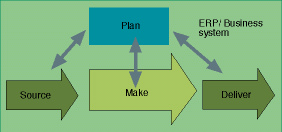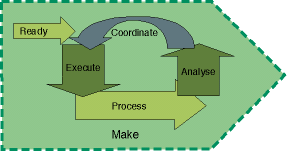
The introduction of new technologies almost always creates a lot of confusion and many misconceptions for those confronted by it. The concept 'manufacturing execution system' (MES) is no exception.
It is surprising, however, that this should be the case, since MES is no longer a new technology, nor is it a very complex concept. While calling it automated production management might be over-simplification, one could say MES uses computer software to do what production managers have always done manually.
The independent evolution of control systems on the shop floor and ERP (enterprise resource planning) systems at head office level left a void in between, which can now be filled by MES software. However simple the concept, it has to be borne in mind that the planning, implementation and maintenance of a full MES system is a hugely complex task that has to be carefully managed and executed to be successful.
This article will by no means cover all the details about MES, but merely attempts to provide the reader with a basic understanding of MES, what it does and where it fits into the production management/plant control information nervous system of an enterprise.
The evolution of ERP systems
Modern ERP systems have evolved from a system called MRP (materials requirements planning). As computers became more powerful, more software models were added until the system came to be known as MRP II (manufacturing resource planning).
ERP systems became increasingly powerful and are now taking care of the planning of virtually all the processes within an enterprise, including financial, sales and distribution, human resources, maintenance management, materials requirements planning, inventory control, purchasing modules and more. MES systems only communicate with those modules of the ERP system that are directly involved in the production process. However, ERP systems still rely entirely on transaction-based information that has to be entered into the system manually. Not only does this cause time delays, but the possibility of human error is introduced, with a potentially detrimental effect on the performance of the ERP system. To overcome this serious obstacle, MES systems have been developed to interact with both the control system and the ERP in realtime.
The evolution of process control systems
Plant engineers have also been influenced by the improvements in the processing power of computers. Plant control systems have evolved from manual control to mechanical, pneumatic, electrical, electronic (analog control) and digital control (PLC and DCS).
Sophisticated computer programs called scada (supervisory control and data acquisition systems) or HMI (human machine interface) are used today to graphically visualise all important process information acquired from the controlling device (PLC or DCS). With masses of realtime information flowing from the plant, many more variables can be calculated and derived by the PLC or the scada system. Many of these variables that are already available on the control level could prove very useful in improving the capabilities of the ERP system.
What is an MES system?
Several definitions exist for MES systems, but for the scope of this article it would suffice to say that it is an integrated computer system that resides between the planning (ERP) and control systems, communicating to both of these and indirectly controlling the manufacturing process.
MES may be divided into core functions and support functions:
Core functions of an MES
The MES must, firstly, be able to interface (connect) to the planning system (ERP). Secondary to the first function, it has to manage work orders, scheduling and executing them according to pre-programmed rules. It also has to schedule and configure each workstation in the process for the particular work order.
Tracking of material movement throughout the manufacturing process and maintaining an accurate inventory of all materials (raw materials, work in progress, intermediate goods and final product) makes up another important function of the MES system. Data collection and storing information concerning the manufacturing process for later reports and for communicating to the ERP also forms part of its workload.
Finally, the MES has to be able to detect unanticipated events (machine failure, poor quality etc) and respond to such events. Orders can be rescheduled; maintenance orders can be initiated etc.
Support functions of an MES
Many support functions can be configured into an MES. Some commonly used functions include maintenance management, time and attendance, statistical process control, quality assurance, process data/performance analysis, document/product data management and genealogy/product traceability.
e-commerce and its impact on the manufacturing plant
e-business is a fairly new influence on modern process control. While it might be seen as a useful technology enabling companies to provide better service to their clients and improve productivity, the impact of e-business on a manufacturing facility has to be carefully considered.
The implication is that orders will increase in number and variety while decreasing in size, placing additional strain on production and supply infrastructure. Manufacturing facilities, therefore, will have to be more flexible than ever before to cope with these increasingly demanding conditions, while machinery breaking down, quality problems, unexpected component failures etc will have to be addressed a lot quicker and more accurately than before.
Such flexibility is only possible if the manufacturing process is controlled by a sophisticated computer system or MES and cannot be achieved using the current paper-based production planning and execution techniques.
The REPAC model
This is a refinement of the previous supply chain business model, developed by AMR Research (Do We Need A New Model for Plant Systems? - The AMR Report on Manufacturing - 1998)

Figure 1 shows a diagram representing the supply chain from raw materials received, to production and delivery of a final product to the customer.
All the processes in this model have to be carefully planned for optimum results. The model was later refined in the sense that the 'make' process had to be considered in more detail. This gave rise to the so-called REPAC model (Figure 2).

Ready
Readies production for the introduction of new product lines, or for engineering modifications to old ones. In fact this process allows the definition of the most suitable plant configuration for the manufacture of the new/changed products. It also administers product and process improvements, including corrective actions for detected noncompliance.
Execute
Executes an optimised production plan to ensure that products comply with their specification. It also provides PROCESS with the suitable machinery configuration (set-up) needed to make a specific product. The majority of Historical MES functions are included in this step, but some important functionality such as finite capacity scheduling and product quality are located elsewhere.
Process
Process includes all the features needed to physically produce the product(s). It also provides a means to automate and control the process.
Analyse
Allows supervisory personnel to analyse meaningful data from all sources and so evaluate production performance, product quality, process capability and regulatory compliance. Data is also made available to the ERP and supply chain management system, as well as to customers and suppliers for analysis purposes.
Coordinate
Co-ordinates plant operations with the enterprise and supply chain. It defines the optimised sequence of plant activities to meet the production requirements defined by demand management.
The Cube integrated plant system (IPS)
Cube is a suite of software and hardware products developed by Orsi to manage a complete manufacturing process, from the control level up to the MES level. The four main products that make up the suite are:
* Cube ICS (integrated control system). A full range of control hardware and software - including field I/O modules, PLC, DCS and programming software.
* Cube HMI (human machine interface).
* Cube MES (manufacturing execution system). All the tools required to build a complete set of MES functions (including Cube TRACK, Cube X-BATCH and Cube SPC for statistical process control).
* Cube MESAD (MES Administrator). A rule-based framework engine that encapsulates components to coordinate and synchronise events and actions in the production process. This makes full use of the REPAC model and offers the user the opportunity to closely follow REPAC methodology in the full cycle of system development ie analysis, implementation and administration.
Software architecture
From a software/networking point of view, the MES system has to fulfil certain important requirements.
Openness - the system has to be able to communicate to a wide range of third party applications, from control systems to scada to business-to-business applications and ERP systems.
Scalability - the system has to able to be implemented on a small scale (on one computer only) through to a fully-fledged multi server, multi client system, with Internet capability.
Maintainability - to maintain a software system spanning several countries in more than one continent can prove to be a real problem. Imagine having to upgrade the versions of software on all these computers, all at the same time.
Using the n-tier client server system as described above COM and DCOM technology enables one to upgrade the clients automatically from the servers. Lean and thin clients, making use of COM, DCOM and the Internet, do not have to upgrade at the same time as they rely on the standard communications interface standards previously mentioned.
Cube was designed to run under Windows NT and has adopted the three-tier client/server architecture proposed by Microsoft. It makes use of data servers, application servers and a range of fat, lean and thin clients. This architecture enables Cube to be used from standalone applications to very large ones spanning several servers and clients across local area networks as well as wide area networks and the Internet.
Conclusion
MES systems are only new to the traditional control system fraternity, because they have never been involved in production management. Similarly, production people have never been exposed to real plant control issues. Plant control engineers and production people often see each other as an obstacle in doing their jobs. MES, combining these two fields, is going to rely heavily on these two camps to join forces and work together as a team.
Another important factor is finding the right supplier of MES systems. Before a supplier is chosen the client has to be convinced that the product offering can satisfy all the support functions as described under the heading 'What is an MES system?'
Orsi
(031) 765 4255
www.orsi.co.za
© Technews Publishing (Pty) Ltd | All Rights Reserved